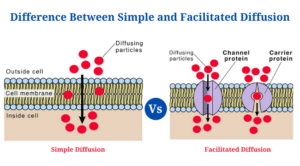What is Simple Diffusion ?
Simple diffusion is an unassisted type of diffusion in which a particle moves from a higher to a lower concentration. The directional movement through the concentration gradient is passive. Once the molecules become evenly distributed, the molecules on the either sides of the cell membrane achieve an equilibrium where no net movement of molecules is observed. Generally, small non-polar molecules like oxygen, carbon dioxide, and ethanol freely diffuse across the cell membrane.
simple diffusion is a form of diffusion that does not require the assistance of membrane proteins. In essence, the particle or substance moves from higher to lower concentration. However, its movement does not need a membrane protein that will help substances to move downhill.
What is Facilitated Diffusion ?
Facilitated diffusion is the transport of substances across a biological membrane from an area of higher concentration to an area of lower concentration with the help of a transport molecule. Since substances move along the direction of their concentration gradient, chemical energy is not directly required. Examples of biological processes that entail facilitated diffusion are glucose and amino acid transport, gas transport, and ion transport.
Difference Between Simple Diffusion and Facilitated Diffusion
(Simple Diffusion Vs Facilitated Diffusion)
| Characteristics | Simple Diffusion | Facilitated Diffusion |
| Definition | Simple diffusion is a sort of passive diffusion that happens when the electrochemical potentials on both sides of a permeable barrier are different, as the name implies. | Facilitated diffusion is a type of biological transport in which specific structural components of biological membranes interact with specific solutes or classes of solutes, allowing them to pass the membrane at significantly faster rates. |
| Driving Force |
The concentration gradient across the membrane is the driving factor for simple diffusion. |
The driving force for facilitated diffusion is the difference in solute concentration across the membrane. |
| Energy requirement |
Diffusion is a passive mode of transport that does not require any energy. |
Although assisted diffusion is a passive transport mode that requires no energy, some facilitated diffusion mechanisms are active. |
| Speed |
Simple diffusion moves at a snail’s pace. |
Facilitated diffusion has a faster rate than unfacilitated diffusion. |
| Solute specificity |
Simple diffusion is not a solute-specific mechanism. |
The selectivity of the solute and carrier molecules directs facilitated diffusion. |
| Additional forces |
The kinetic energy of the molecules, in addition to the concentration gradient, drives the process of simple diffusion. |
In addition to the concentration gradient, kinetic energy drives the process, as it does in simple diffusion. |
| Inhibition |
An inhibitor molecule has no effect on simple diffusion. |
Specific inhibitor molecules can prevent diffusion from being facilitated. |
| Direction of movement |
The migration of particles in simple diffusion occurs in the direction of the concentration gradient. |
Molecules can travel in both directions and opposing directions of the concentration gradient in assisted diffusion. |
| Size of molecules | The transit of tiny non-polar molecules is primarily governed by simple diffusion |
The passage of big and polar molecules across a biological membrane is frequently facilitated by diffusion. |
| Channel proteins | Simple diffusion happens when molecules travel across the membrane’s general surface. | Facilitated diffusion occurs when channel proteins are involved, resulting in the development of specific pores for the flow of molecules. |
| Examples | Simple diffusion can be seen in the exchange of gases between the lungs and the blood, in the mixing of gases in the environment, and in the absorption of nutrients by bacteria. | Facilitated diffusion includes the transfer of ions such as calcium and potassium, the movement of oxygen in the blood via hemoglobin, and the transport of amino acids and glucose from the blood to the cell. |
Click Here for Complete Biology Notes
Simple Diffusion and Facilitated Diffusion Citations
- https://www.thoughtco.com/diffusion-and-passive-transport-373399
- https://www.easybiologyclass.com/difference-between-simple-diffusion-and-facilitated-diffusion-a-comparison-table/
- https://en.m.wikipedia.org/wiki/Membrane_transport_protein
- https://www.biologyonline.com/dictionary/facilitated-diffusion
- https://quizlet.com/92068105/ap-physio-ex-flash-cards/
- https://quizlet.com/15699694/chapter-14-review-flash-cards/
- https://brainly.com/question/1382789
Related Posts
- Phylum Porifera: Classification, Characteristics, Examples
- Dissecting Microscope (Stereo Microscope) Definition, Principle, Uses, Parts
- Epithelial Tissue Vs Connective Tissue: Definition, 16+ Differences, Examples
- 29+ Differences Between Arteries and Veins
- 31+ Differences Between DNA and RNA (DNA vs RNA)
- Eukaryotic Cells: Definition, Parts, Structure, Examples
- Centrifugal Force: Definition, Principle, Formula, Examples
- Asexual Vs Sexual Reproduction: Overview, 18+ Differences, Examples
- Glandular Epithelium: Location, Structure, Functions, Examples
- 25+ Differences between Invertebrates and Vertebrates
- Lineweaver–Burk Plot
- Cilia and Flagella: Definition, Structure, Functions and Diagram
- P-value: Definition, Formula, Table and Calculation
- Nucleosome Model of Chromosome
- Northern Blot: Overview, Principle, Procedure and Results

















